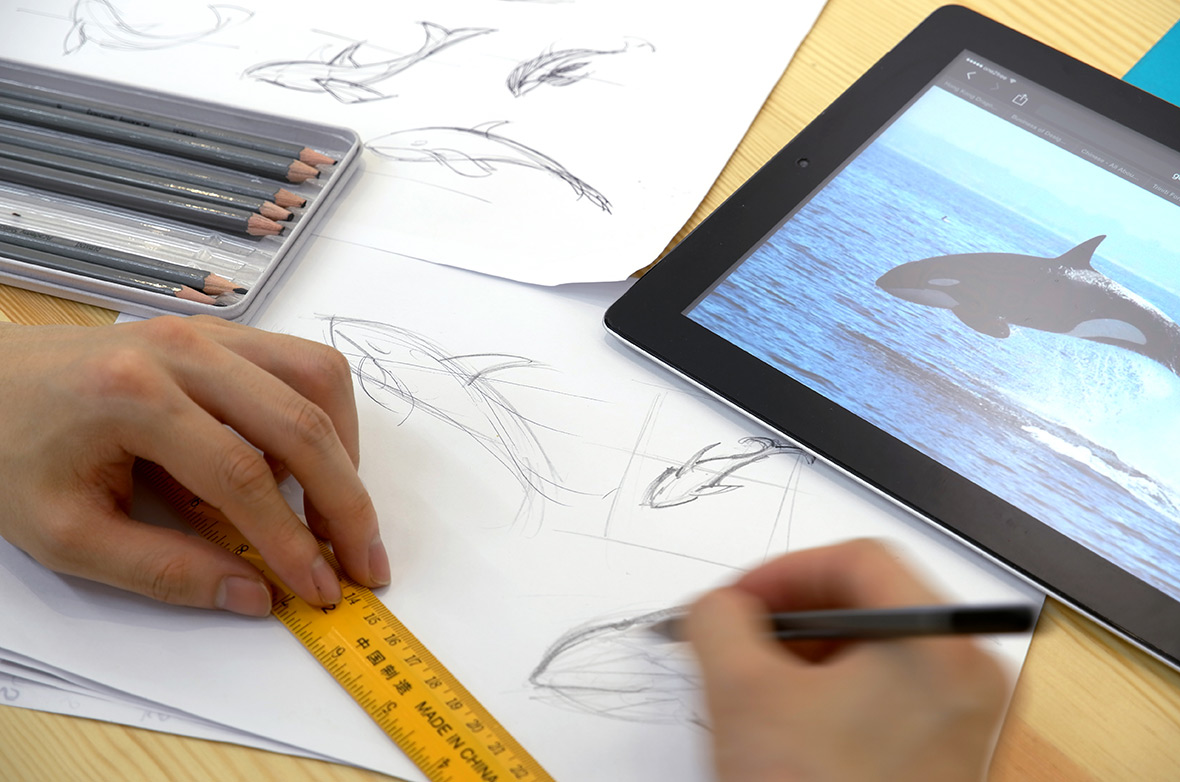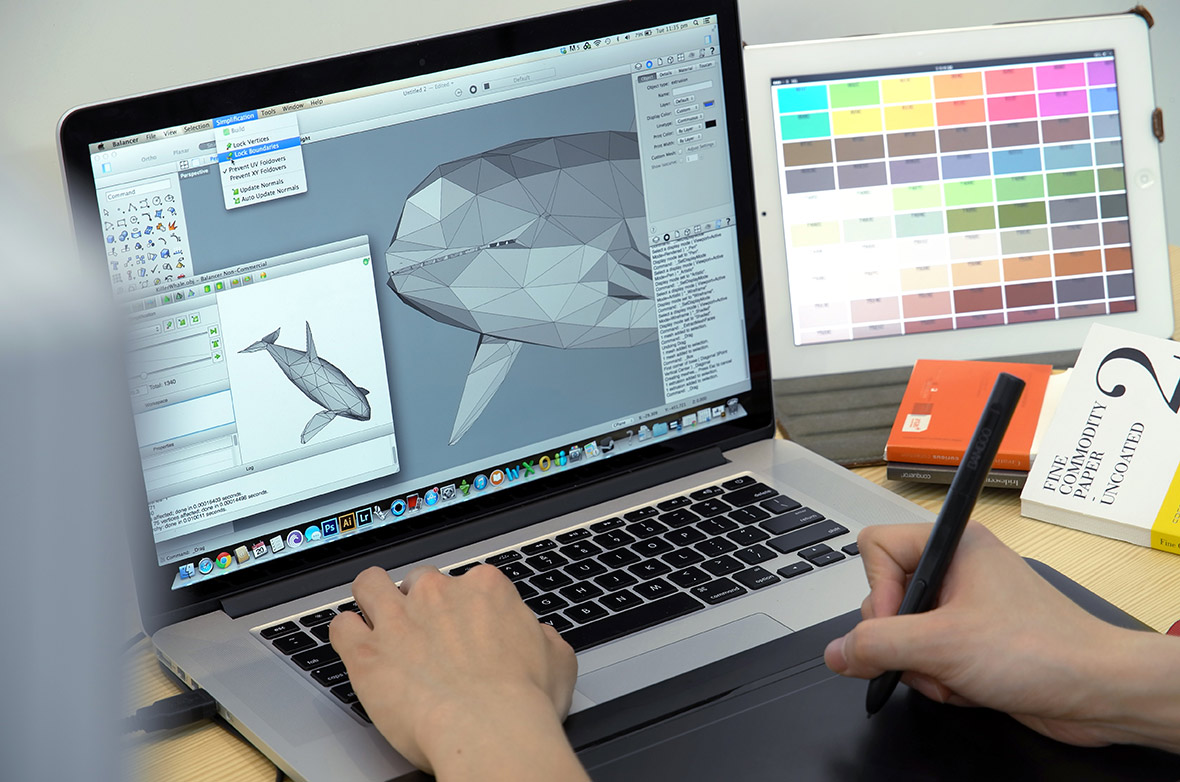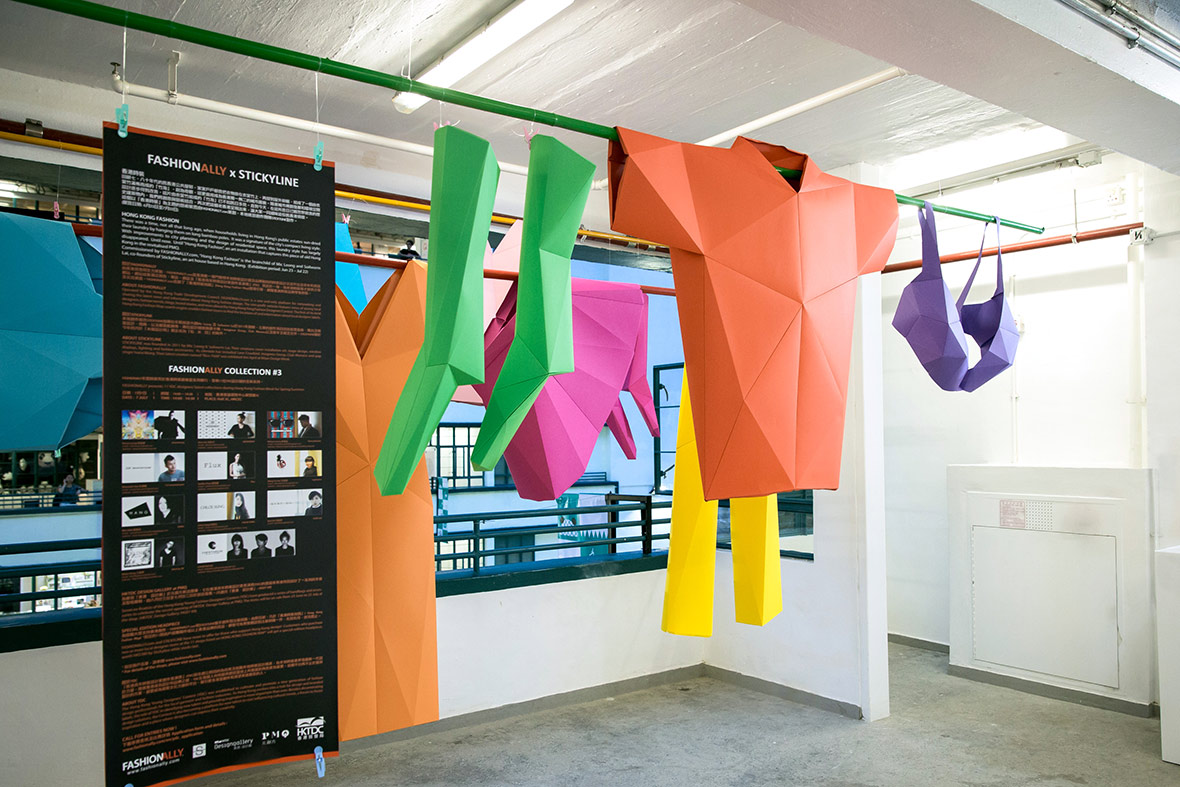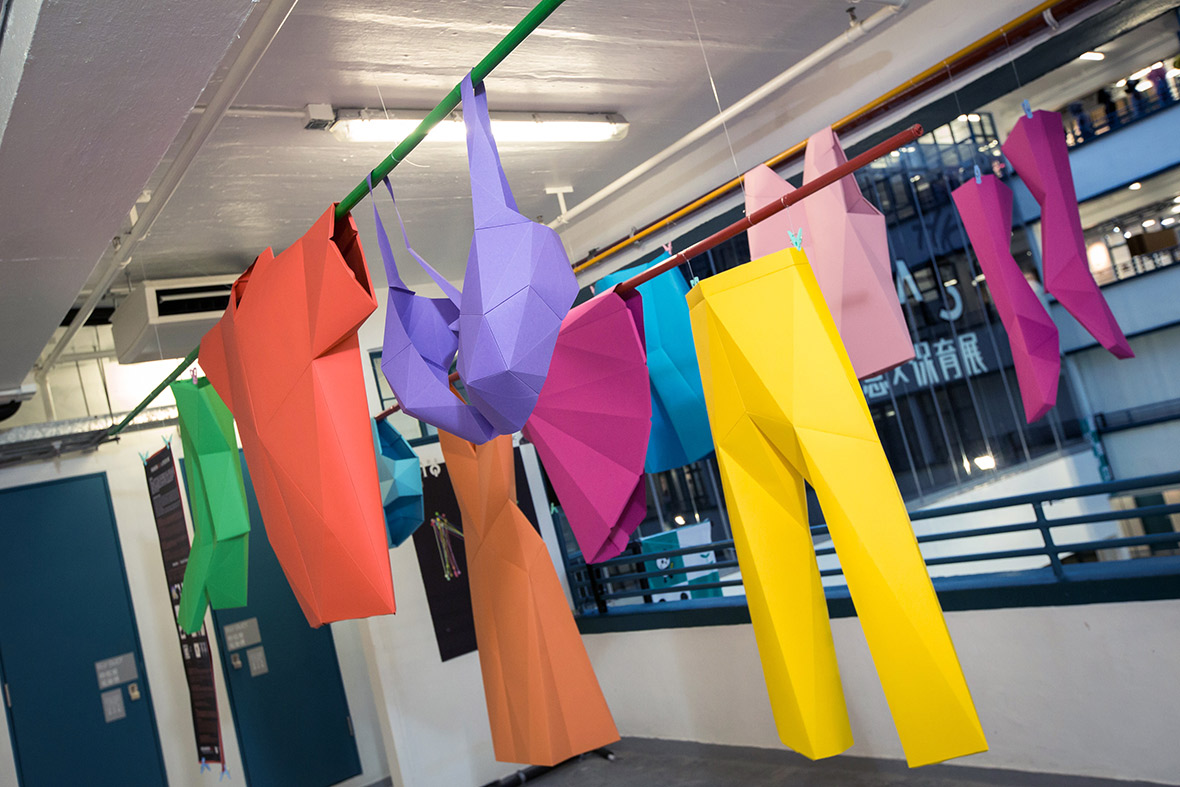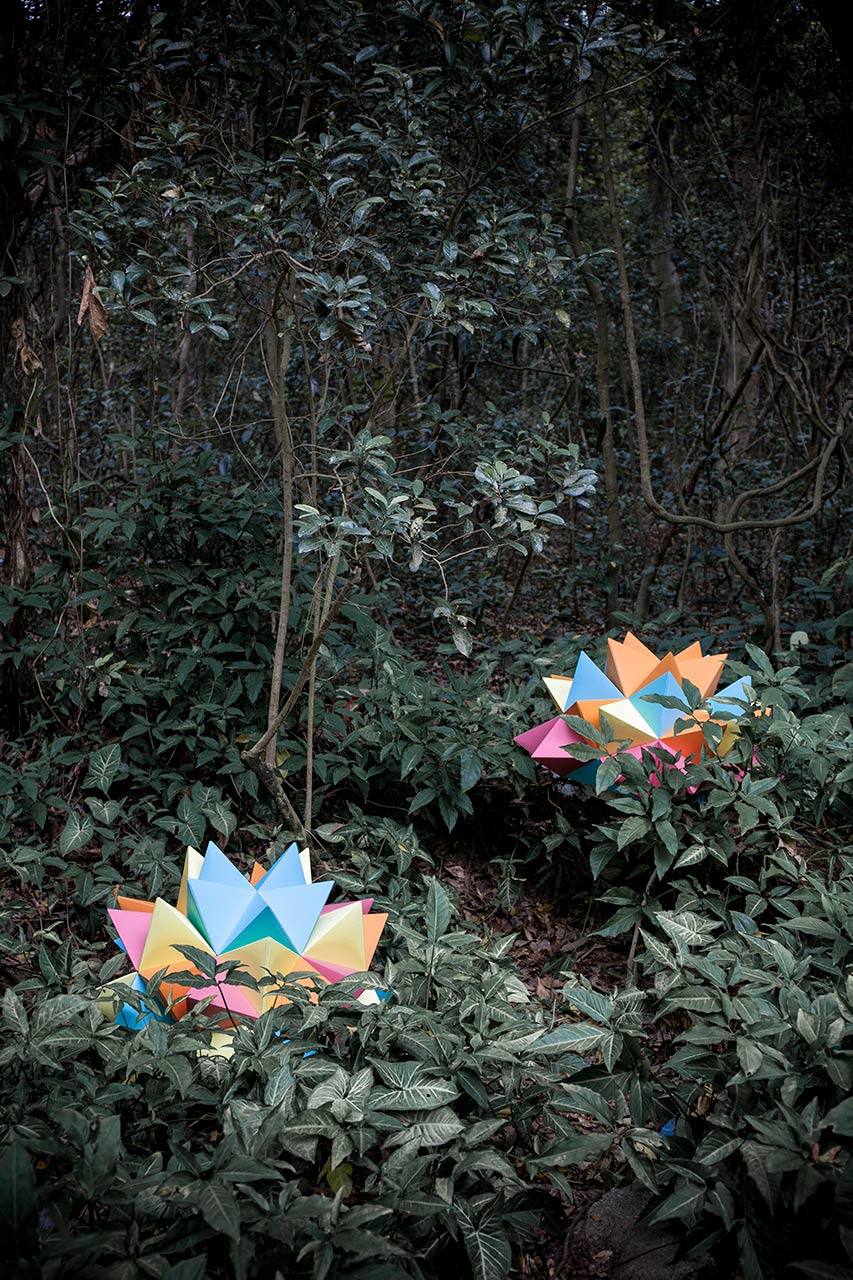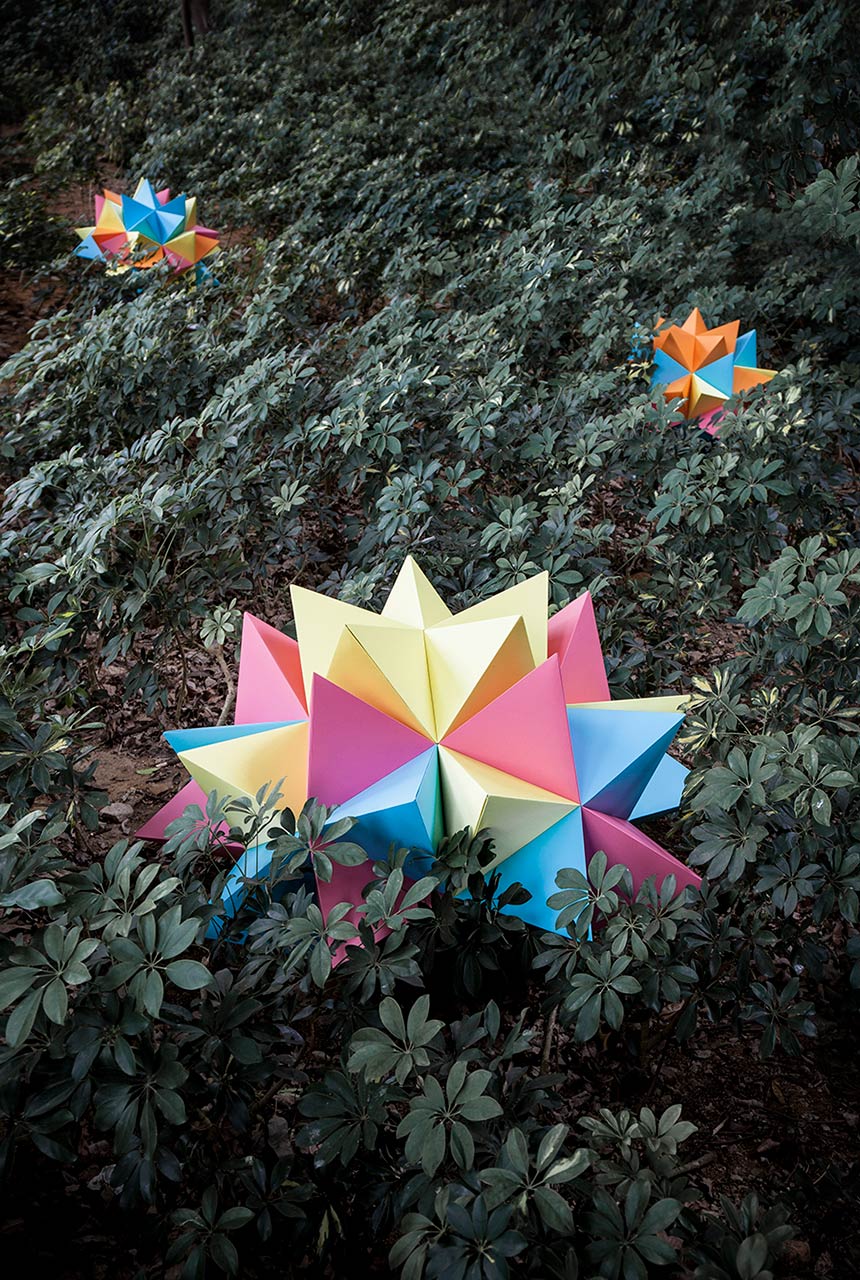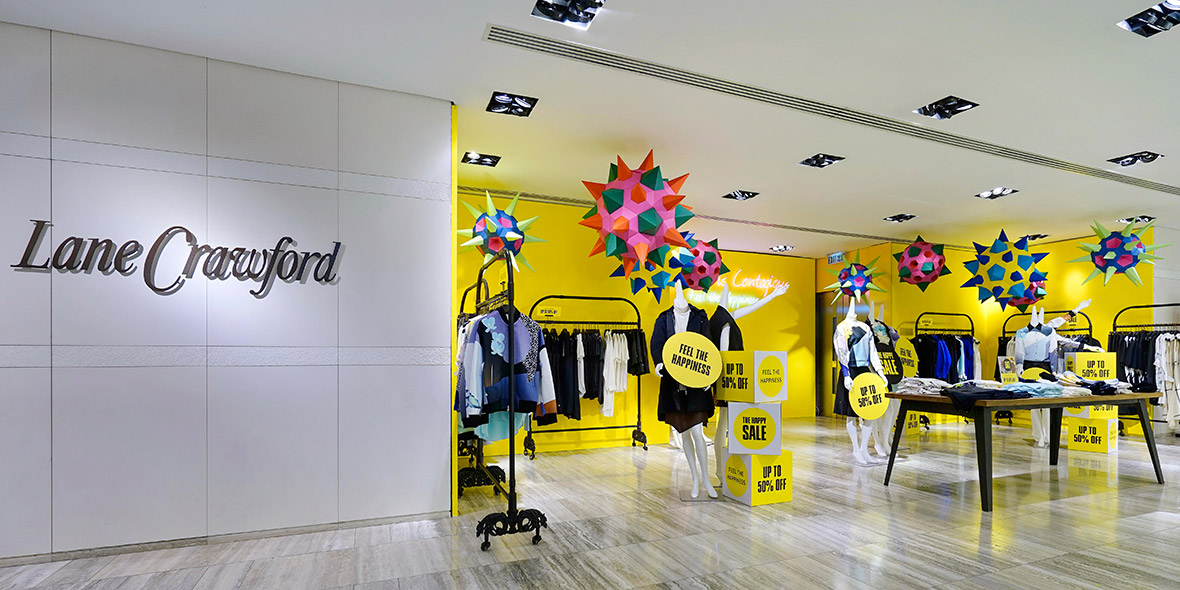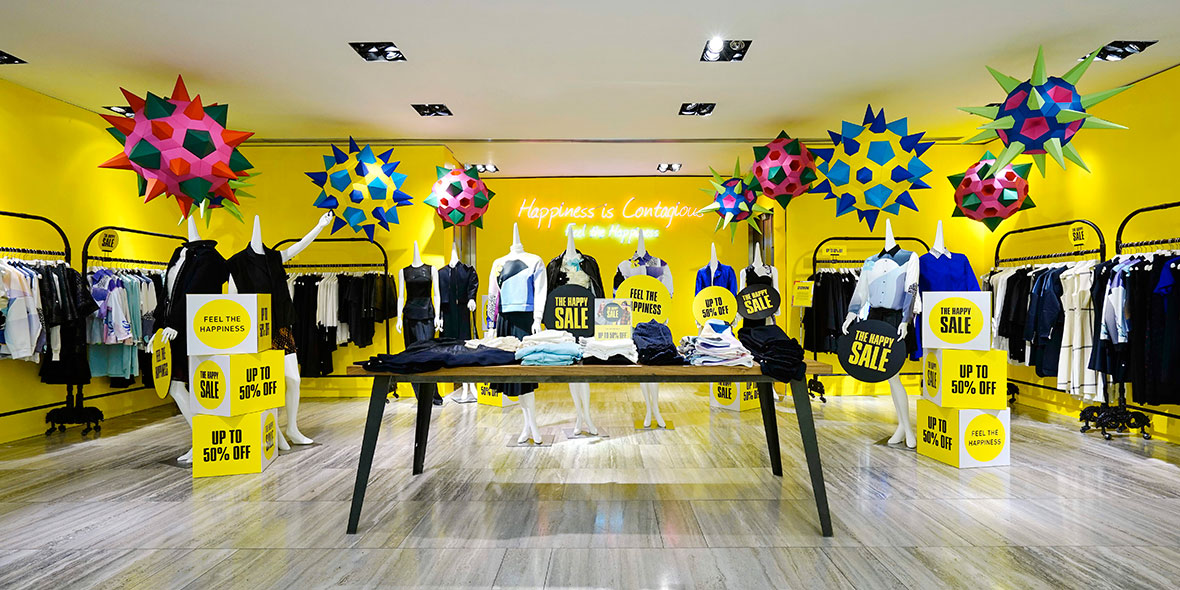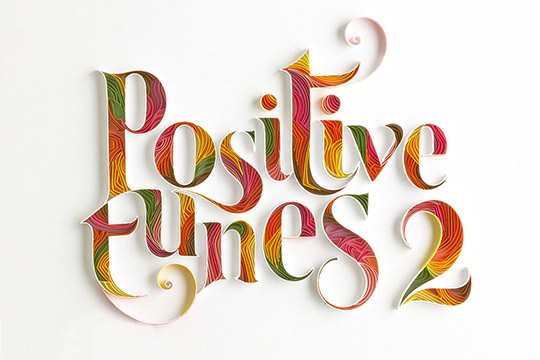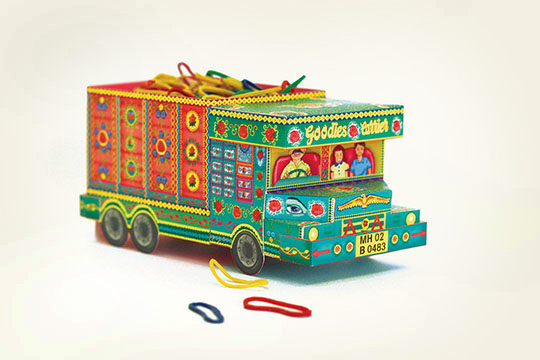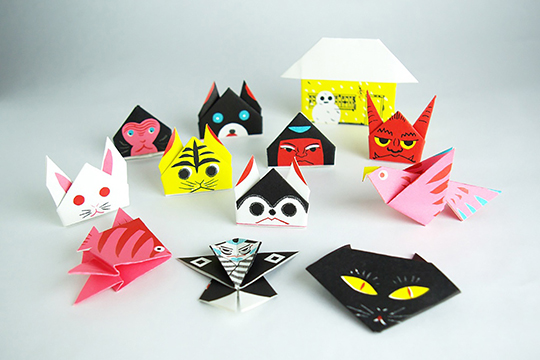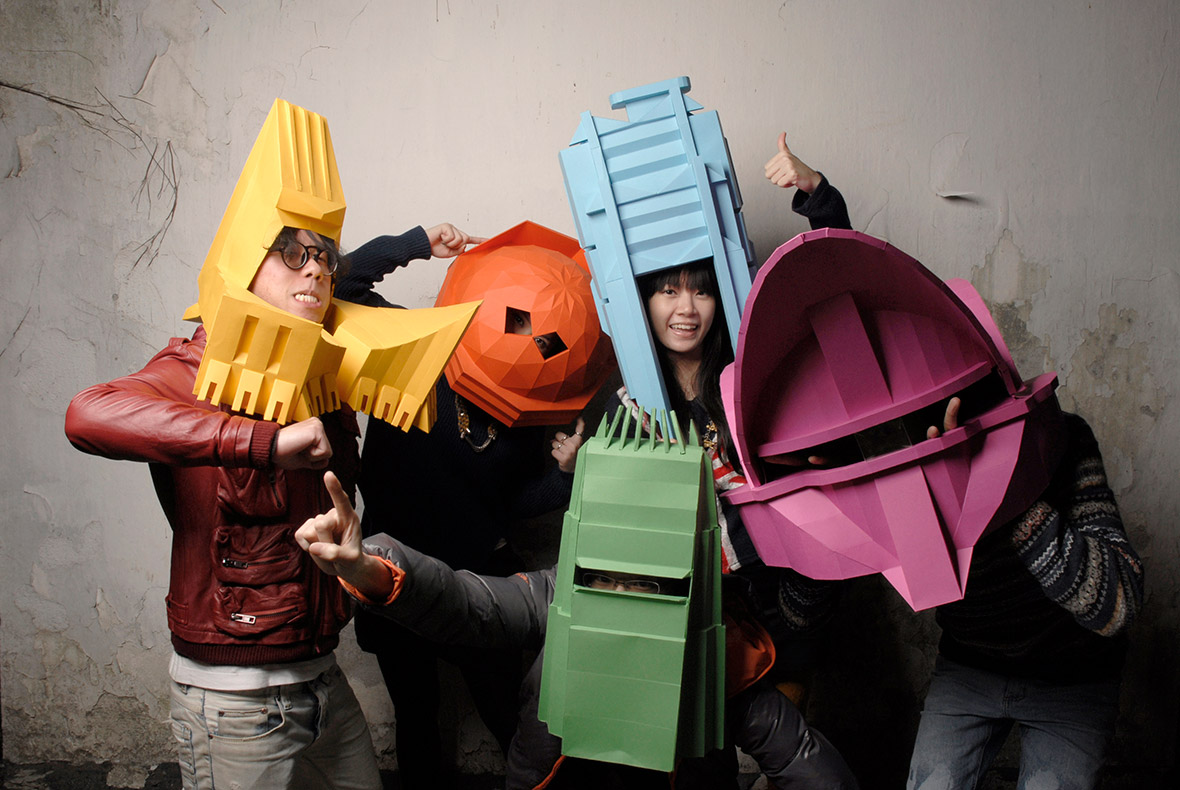
Stickyline is a Hong Kong-based creative duo that manipulates and reengineers paper in ingenious ways. The team is comprised of two designers, Soilworm Lai and Mic Leong, who both graduated from the Hong Kong Polytechnic University School of Design with majors in industrial and product design. They transform two-dimensional images into three-dimensional objects through a process of deconstruction and reconstruction. Their creative manipulation of paper results in complex installation art, stage designs, and sculptures. Many might associate Stickyline’s creations with Japanese origami, since they employ creative folding techniques similar to origami, but a big differentiating factor is that Stickyline’s end products are more like three-dimensional puzzles. With their elaborate paper creations, they have managed to narrow the gap between imagination and reality that much more.
Stickyline是香港的雙人紙藝創意團隊,由畢業於香港理工大學設計學院的前包裝設計師Soilworm Lai和前玩具設計師Mic Leong創立於2011年。二維平面轉換到三維立體形態,在解構和重構之間,Stickyline以紙為材料制作裝置、雕塑和舞臺設計,進行跨領域創作,為想象與現實創造了新維度。雖然同樣有很多折疊,但不同於日本折紙藝術——盡管這是很多人首先會聯想到的,Stickyline的作品更像是3D拼圖,這也是他們之間的根本區別。
Computer 3D modeling is an important part of the production process in all of Stickyline’s projects. Whether it is a personal project or a commercial project, Soilworm and Mic have to think very carefully about all the different factors that are involved with their different creations; for example, they need to consider the space that their designs will eventually occupy. The two first brainstorm together and sketch out an initial design, then afterwards they digitally develop it into a three-dimensional model. After a meticulous research and analysis phase, they next begin to plan out how their installation will occupy the space that it will later be put in. Coming from such similar backgrounds, these two designers are able to work harmoniously side by side, from the initial brainstorming stage all the way up to the actual production.
Stickyline的作品創作過程中,有著相當關鍵的一步,就是計算機3D建模。當然在此之前,不管是個人創作還是客戶項目,Soilworm和Mic都會通過實地考察全面理解將用於展示作品的空間。在把頭腦風暴過程中產生的設計的大概形態變成3D圖形後,經過無數深入的細節研究和調整,他們盡力讓作品的色彩/材料和形狀能夠與空間安排產生互動。最後分解3D對象,切割出紙張部件,再重新組裝起來,這便是Stickyline最終作品的形成。在這個過程中,兩位設計師的合作也並無明確分工,事實上,得益於他們共同的經歷,他們可以從創意到制作全程合作的天衣無縫。
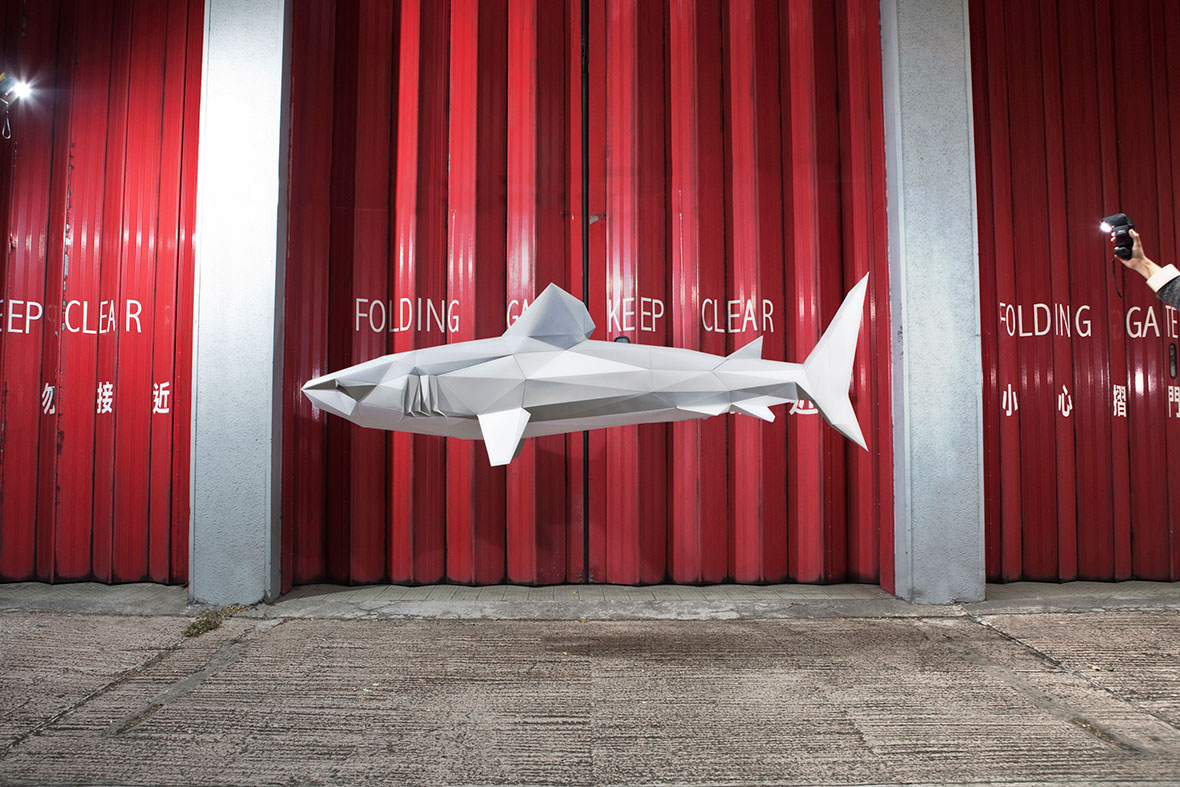
Stickyline has already started collaborating with a large number of well-known local and international brands. Their story began with Masked Creatures, a small project created for Hong Kong’s DesignMart, which consisted of crafting paper helmets in the shape of various well-known Hong Kong architecture. Soilworm and Mic wanted not only to create something that people would find interesting, but they want their work to leave an impression in people’s minds. Just after a few days, their series of colorful and uniquely shaped helmets became a hot topic of conversation and was shared all over social media. For them, gaining the approval of so many people gave Soilworm and Mic more confidence in their art. From that project onwards, their studio’s momentum hasn’t faltered a bit. Stickyline’s paper creations has already expanded into actual products: from accessories, lights, to toys – they’ve even created fashion for local celebrities!
現在的Stickyline與國內外一眾耳熟能詳的品牌都進行過合作。而它的成立則完全源於當初香港DesignMart上的一個叫做《Masked Creature》的小項目。這個項目是Soilworm和Mic為了展示更讓人印象深刻並具有意義的產品,以多邊形的形式重構香港的著名建築原型的一系列紙頭盔。活動的短短幾天,這個系列有趣的外觀就吸引了很多人,作品本身也變成了一個發生對話和分享的媒介。觀眾的熱情回饋讓Soilworm和Mic對這種藝術和手工形式充滿了信心。以這個項目為起點,Stickyline的作品現在已經延伸到各種實際的產品,有時裝飾品、燈具以及玩具,甚至包括本土明星的演出服裝。
Neocha: As we all know, paper, without being properly handled is a very fragile material choice, and you have some larger sized works. We were wondering how you dealt with the situation. What’s the biggest challenge in using paper like this?
Stickyline: It is quite challenging and it is also what makes us different from other paper artists, since we tend to build big objects using paper. The paper we use is tougher and thicker than those normally found in stationary shops. Some papers have different textures and different finishes which make them more durable.
Besides, paper only acts as the skin in our artwork. Our art, being so large, we are forced to create structures that supports the skin by using paper cardboard, wood, and sometimes even metal. For example, when we created a sculpture of a killer whale, paper becomes the skin, and inside the whale, there are structures that are a bit like the bones of the animal. Without it, the paper would collapse.
Neocha: 眾所周知,紙在沒有做合適處理的情況下,是一種很脆弱的材料。而妳們有一些大型的作品,這種情況下,妳們如何應對紙的這個特性呢?在用這種方式創作作品的時候,妳們面對的最大挑戰是什麽?
Stickyline: 妳們提到的這點確實是個巨大的挑戰,同時它也讓我們的作品與眾不同,鑒於我們傾向於用紙做大件的作品。我們通常用比文具店能夠買到的要稍厚一些的紙,包括有些不同質感的紙,以及不一樣的完成工序讓作品更為結實。
此外,紙只是像我們作品的表皮。大件作品中,我們不得不用厚紙板、木板,有時候甚至是金屬來做結構和支架以支撐那層表皮。例如: 我們的逆戟鯨雕塑,紙只作它的表皮,在逆戟鯨體內我們會做類似動物骨架的支架,否則最外層的紙會坍塌。
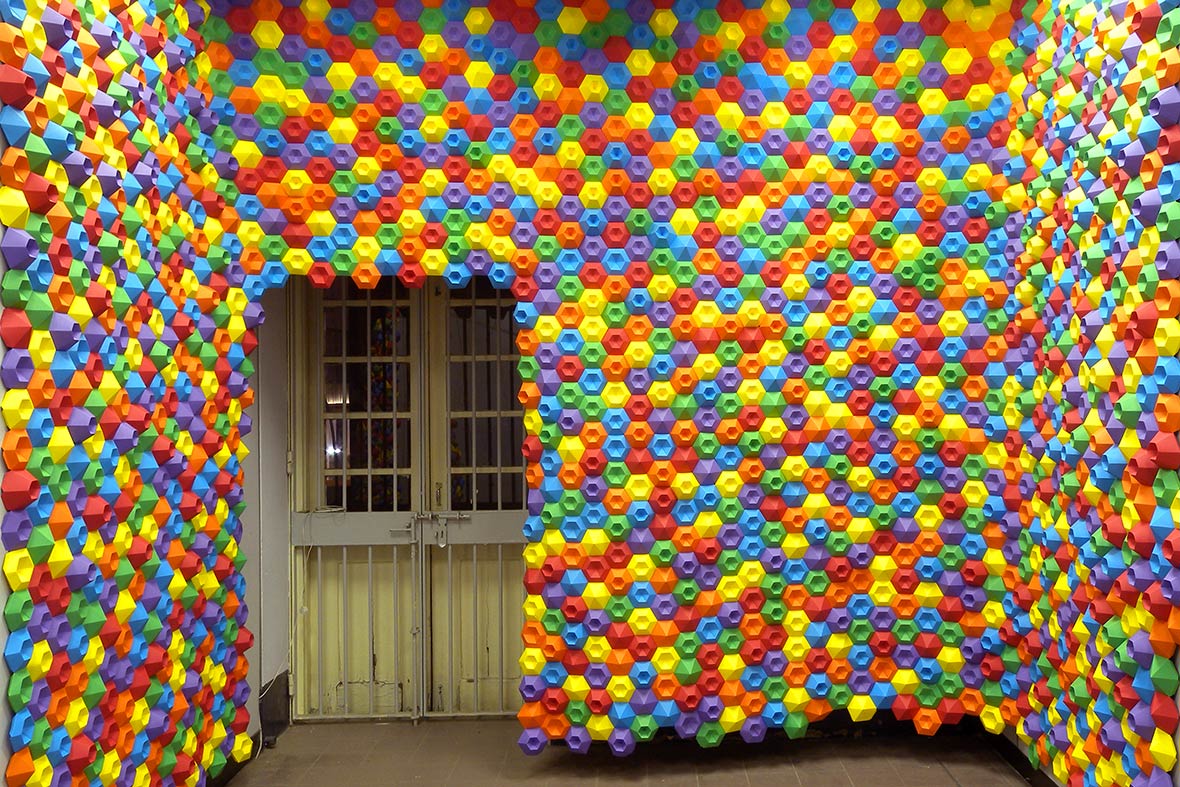
Neocha: Describe for us a couple of your personal favorite designs. Why are they interesting to you?
Stickyline: Coast Modules was the first project that we created which involved interaction with visitors and that was produced with the help of a factory. These things made a big difference in our creative process. The interactive elements added value to our design, and the factory built wonderful paper sculptures with the rules we set up. They then put it together in some random arrangements. The mass production of the factory allowed for more design variety, and at the same time it enriched the content that our visitors can interact with. Employing factory production also helped with the physical size of the project, which scaled it up to something even more impressive.
Another project we want to mention is Bamboo Mountain Bamboo Sea, which took place at a historical building now called PMQ (the former Hollywood Road Police Married Quarters). It is an installation with a setup displaying clothes being hung out to dry and the clothes are much bigger than usual one and it is all made out of paper! It includes clothing that normal people would have: trouser, t-shirts, underwear, bras, dresses, and so on. You can see people walk along the corridor with surprised facial expressions when they see some of the traditional methods of drying clothes recreated in a modern way.
Neocha: 可以告訴我們妳們最喜歡的個人作品是哪些嗎?為什麽?
Stickyline: 《Coast Modules》是我們做的第一個包含觀眾互動的項目,這個項目的制作我們也得到了工廠的幫助。這兩個點給我們的創作帶來了很大不同: 互動元素為我們的設計添加了一層價值,觀眾根據我們設立的規則,以具有個體性差異的手法作出很棒的紙雕塑;工廠的大批量生產則給我們設計上的可能提供了更多的空間,同時它豐富了觀眾可以參與發揮的內容。同時這種制作也幫助我們將作品更大型化,給人更為深刻的印象。
另一個我們要提到的項目是《Bamboo Mountain Bamboo Sea》,它是發生在一個叫做元創方 (前荷李活道已婚警察宿舍) 的歷史建築中。這個裝置,是將衣物按照舊時的晾曬方式懸掛著,這些“衣物”包含了平常大家會穿著的褲子、T恤、內衣、內褲、裙子等等,只是它們的尺寸平常所見要大很多,而且都是紙做的。妳可以看到,經過的人們看到傳統的晾衣形式可以以這麽現代的方式來再現時,他們那按耐不住的驚訝神情。
Neocha: What has been the biggest changes for you and your work over the last four years? And what’s one thing that you stick to no matter what?
Stickyline: We’ve stuck to our original concept of transforming objects from 2D to 3D as well as our style of creating polygon features, lines and planes.
As far as the biggest changes, we’ve actually been trying to design shapes with fewer and fewer polygons, while still keeping the content and details all intact. This requires a lot more precision during production in order to stay true to our initial design. Paper is still the main material in most of our projects, but we’ve tried crossovers involving different things like projections, interactive elements, and adding lighting into our installations.
Neocha: 過去這些年中,妳們或者妳們的創作發生的最大的變化是什麽?哪些又是妳們一直堅持不變的?
Stickyline: 我們一直堅持著在2D和3D間轉換事物的原創概念,一直堅持著創作多邊形物體、線條和平面的自身風格。
要說最大的變化,我們一直嘗試在設計形狀時讓多邊形越來越少,但是仍保有內容和細節,這樣一來,制作時就得要更精確才能實現最初的設計。紙仍然是我們多數項目中的主要材料,但是我們試過在一些跨界創作中往我們的裝置中加入不一樣的,比如投影,互動元素,和光這些東西。
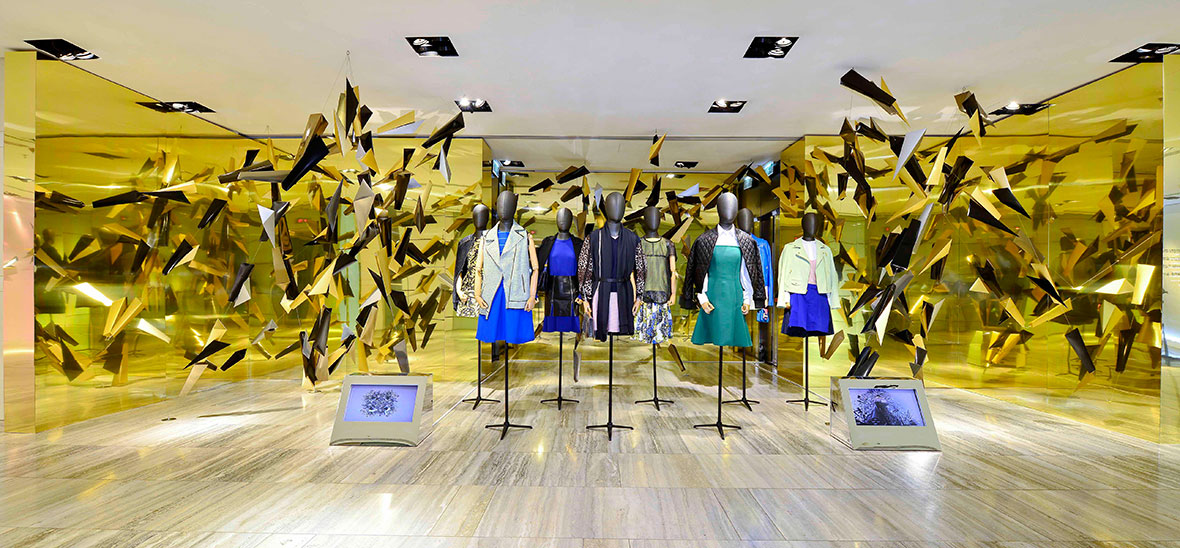
Neocha: How does Hong Kong, the city you’re currently living in, inspire you?
Stickyline: As we always say, our daily life inspire us the most. What we see and experience in this city is an important inspiration to us, and some of our projects address these daily elements from a different perspective. One example is when we made a paper power plug, but scaled up to a huge size, it stood taller than a man including the wire. Shifting people’s perspective to focus on the little things again is exciting and makes us happy.
Neocha: 妳們現在居住的城市,香港,對妳們的創作有什麽樣的啟發呢?
Stickyline: 正如我們一直說的,日常生活才是啟發我們最多的。所以在香港的生活必然也是如此。在這座城市中,我們眼見的,我們身歷的,都是很重要的靈感來源。我們有些項目就是用不一樣的視角,去突出這些日常元素。舉個例子,我們曾經做了一個大尺寸的紙插頭,差不多是原實物的10多倍大。算上它線的部分,它立在那裏比人還高。讓人們重新註意到這些小事小物,總是讓我們感到開心和激動。
Neocha: What do you have in the works for the near future?
Stickyline: We always want to develop even more products. We have some ideas in mind but haven’t had the time to flesh them out fully yet. We hope we can hit the mark with these ideas. Besides that, we also have some new commercial work, prop designs, and set designs all in progress. We will take part in an exhibition in Singapore, a project to test people on how well they know their fears.
Neocha: 能告訴我們一些未來的創作計劃和項目嗎?
Stickyline: 我們總是想要開發一些產品,現在已經有一些想法了,但是還沒有時間去完全實現包裝它。我們希望可以在未來完成這個設想。除了一些商業道具設計和場景設計,我們也將參加在新加坡舉辦的一個展覽,這是一個測試人們對他們自身恐懼的認知的項目。


